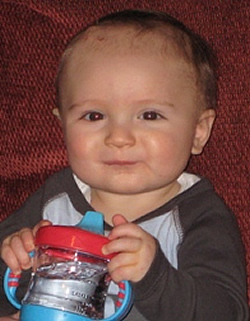Miracle Kids: Jack Albanese
Infant Survives Life-Threatening Fall
 One chilly weekday morning in December 2007, Rochesterians Christyn and Jeff Albanese were juggling getting themselves ready for work with keeping an eye on their bubbly 7-month-old, Jack.
One chilly weekday morning in December 2007, Rochesterians Christyn and Jeff Albanese were juggling getting themselves ready for work with keeping an eye on their bubbly 7-month-old, Jack.
Christyn had set Jack down on her bed, boosted by a Boppy pillow and outfitted with a couple favorite toys. Turning around for brief moment to thread cuff links through her blouse, she heard a thud.
“That noise has replayed a million times in my mind,” she said.
Jack was laying face-down on the floor, crying. She scooped him up, and he began nuzzling into her arms, whimpering; only his cry wasn’t fierce enough.
“It wasn’t the howl you’d expect,” she said.
In no time, the couple brought Jack to see Laura Price, M.D., a pediatrician at Pathway Pediatrics, in Rochester, and a former chief resident at Golisano Children’s Hospital. Price had treated Jack for an ear infection just the week before, and was shocked to see the lively boy now behaving like a rag doll.
Price told the couple that she would phone ahead while they took him straight to the children’s hospital; within 15 minutes, Jack was having his first CT scan. Though it showed a small bleed, his actions hinted more was at stake—he couldn’t hold his head up, and he wasn’t getting enough oxygen.
“Doctors inserted a breathing tube, and panic hit us,” Albanese said.
Thankfully, successive tests soon shed more light on Jack’s condition—a dye used in the scan was seeping out of the blood vessels, suggesting that the vertebral artery, near the base of the brain, had torn.
Lucky for Jack, that particular artery has a “spare” of sorts. If part is damaged, the blood can be rerouted through a new course, posing little to no trouble later in life.
But two hurdles needed to be cleared first—and fast. Jack needed a tube to help drain excess fluid away, so pressure didn’t mount inside his skull. And, to help clot the bleeding, interventional radiologists would have to thread a catheter through his artery—sacrificing part of it, and directing blood along the “spare” route instead. “With a baby like Jack, this is all a delicate balancing act,” said Jonathan Mink, M.D., chief of Child Neurology at the University of Rochester Medical Center and one of Jack’s specialists.
Thankfully, both interventions worked; the bleeding stopped later that night, and the inner-skull pressure eased. But more obstacles loomed—especially the risk of vessel spasms, in which blood that leaks outside the arteries can irritate vessels and potentially trigger stroke. After a short honeymoon period, these spasms could onset within 4 to 14 days. “We watched Jack like a hawk,” Albanese said.
On his fifth day, a grand mal seizure shook him for 8 minutes.
“I remember the hopelessness of waiting that out,” she said. “Every time we were warned that Jack ‘wasn’t out of the woods’ was a kick in the stomach. But we needed this honesty.”
After beginning medicines to help ward off the vessel spasms and seizures, another question rose: whether or not Jack could live without a permanent shunt.
“Sometimes, after injury, children are able to begin absorbing and draining their own brain-spinal fluids—and sometimes, we have to implant a shunt to help,” Mink said.
After a few days of careful monitoring, doctors realized Jack’s case was one of the latter; they installed a valve inside that helps him send fluids to other parts of his body.
Meanwhile, Christyn’s mom had friends spreading the word; prayer chains were taking root internationally, and they seemed to be helping.
“Jack was babbling, and his strength was returning,” Albanese said.
Three days after shunt surgery, Jack was cleared to go home. The family packed piles of get-well cards, a zoo’s-worth of stuffed animals, and even a miniature Christmas tree from Jeff’s parents (both sets of grandparents had come bearing gifts and food, determined to not let Jack’s first holiday get lost in the shuffle).
“What a joy it was to send him home after a potentially life-threatening injury, knowing that everyone else would see him as just another healthy baby,” Mink said. “We’ll follow up with him, but we have good reason to believe he’ll go on to live a full, regular life.”
Just weeks later, Jack was back to being an 8-month-old wiggle-worm—grabbing at things, eating voraciously, acting so curious, so alert, that it was almost as if he were trying to make up for the month he had missed.
His parents are overjoyed to see their little boy back to his old, nosy self.